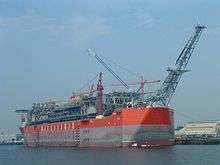Bonga Field
The Bonga Field is an oilfield in Nigeria. It was located in License block OPL 212 off the Nigerian coast, which was renamed OML 118 in February 2000. The field covers approximately 60 km2 in an average water depth of 1,000 metres (3,300 ft). The field was discovered in 1996, with government approval for its development given in 2002. The field began first production in November 2005. The field is worked via an FPSO vessel. The field produces both petroleum and natural gas; the petroleum is offloaded to tankers while the gas is piped back to Nigeria where it is exported via an LNG plant. The field contains approximately 6,000 mm barrels of oil.
| Bonga oil field | |
|---|---|
| Country | Nigeria |
| Block | OML 118 (formerly OPL 212) |
| Offshore/onshore | Offshore |
| Operator | Shell Nigeria |
| Partners | Royal Dutch Shell ExxonMobil Total S.A. Eni |
| Field history | |
| Discovery | 1996 |
| Start of production | November 2005 |
| Abandonment | 2022 (Estimated) |
| Production | |
| Current production of oil | 202,000 barrels per day (~1.01×107 t/a) |
| Year of current production of oil | 2006 |
| Current production of gas | 144×106 cu ft/d (4.1×106 m3/d) |
| Estimated oil in place | 965 million tonnes (~ 234×109 m3 or 1470000 million bbl) |
| Producing formations | Middle to Late Miocene unconsolidated turbidite sandstones |
The field is operated by Shell Nigeria who own 55% of the license. The other partners in the field development are Exxon (20%), Nigerian AGIP (12.5%) and Elf Petroleum Nigeria Limited (12.5%)
Field history
Located 120 kilometres (75 mi) southwest of the Niger Delta, the first discovery well was spudded in September 1995 after acquiring extensive information about the block via a 3D seismic survey in 1993/94.
A secondary field was discovered in the block in May 2001 known as Bonga SW, which encountered significant hydrocarbons. A third field was discovered later in 2004 which is known as Bonga North.
Field development

The field has been produced as a subsea tie back to a Floating Production Storage and Offloading vessel (FPSO). Currently there are 16 oil producing and water injection wells on the field. However, this will be increased to nearly 40 wells as the field is developed further. Due to the large size of the Bonga SW it is currently thought it will require separate production facility to adequately produce the field.
Oil produced from the field is stored on the FPSO for transport to markets via tankers while the gas is exported via a pipeline to the Nigerian Coast for LNG.
The FPSO was built by Samsung Heavy industries. It contained a number of firsts for its type. The SURF (Subsea, Umbilicals, Risers, Flowlines) contract was won by Stolt Offshore (later renamed Acergy and now Subsea7 ). Stolt vessel POLARIS installed all the flowlines and subsea structures in J-Lay and S-Lay pipelay modes.
Production at the well was shut down for three weeks after 19 June 2008, after an attack by the Movement for the Emancipation of the Niger Delta.
2011 oil spill
On 20 December 2011 an oil spill occurred that "likely was less than 40,000 barrels, or 1.68 million gallons [6.4 megalitres]". It resulted in an oil slick 185 km (115 mi) long off the Nigerian coast. It was probably the worst spill in the area for a decade. Oil spills have the potential to cause great damage to the environment, for example water pollution, which reduces fishing yields and agriculture, which is one of Nigeria's largest industries. [1]
References
- "Shell oil spill off Nigeria likely worst in decade". The Guardian. AP. 22 December 2011. Retrieved 15 February 2012.
External links
- Bonga Deep water Project from Shell Nigeria
- "The Bonga Field". Rigzone. Archived from the original on 9 April 2006. Retrieved 23 September 2006.
- "Bonga Deepwater Project, Niger Delta, Nigeria". Offshore Technology. Retrieved 13 June 2007.
- "Shell's Bonga Oil Field Starts up Offshore Nigeria". Azom.com. Archived from the original on 7 June 2007. Retrieved 13 June 2007.
- "Nigerian Bound Bonga Hailed a Major Success for AMEC". Amec Homepage. Archived from the original on 8 October 2007. Retrieved 13 June 2007.